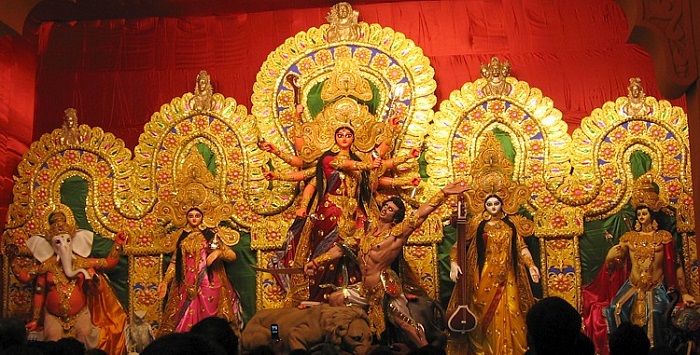Dussehra in Bengal celebrated as Durga Pooja
Celebration of the festival of Dussehra and Navaratri in Bengal and eastern India is indeed unique. No other festival anywhere can match the Pooja season in grandeur, rituals, expression of family bonds and sheer size of mass participation.
The story behind
The nine nights and ten days of ‘Pooja’s’ in Bengal, are the most important days of the Bengali calendar- when the family gets together to first of all shop till they drop, followed by a whole set of activities within homes and outdoors that can only be described as furiously festive. The days start early- in fact very early- to traditional music on radio played out everywhere. Each day of this period packs in a different ritual. They begin with non-stop early morning music on the Mahalaya, when the ‘Maa’ arrives. It is believed that Durga, referred fondly as Mother or Maa comes down every year to our earth to visit her ancestral home from her husband’s.

Legend has it that, Maa Durga is told of the need to destroy the evil demon Mahishasura. All major gods arrive one by one and deliver their most potent weapons to help her in the task. The activities in the first days after Mahalaya are symbolic of such collection of weapons. Weapons and implements collected are worshipped on the sixth day prior to the actual battle with the demon. Victory over the demonic Mahishasura is finally achieved on the eighth day (Ashtami). That day signals commencement of elaborate Poojas with drum beats, clanging of cymbals and Artis performed in a dance form. The joy and relief are expressed through these offerings to the Mother for having vanquished Evil and for ensuring peaceful life to the people. The ninth day is observed as Rama Navami- the belief being that Lord Rama derived necessary lessons from the success of Mother Durga in his campaign to defeat and destroy the evil king Ravana.
The celebration
The ten-day Pooja period is the most celebrated festival in Bengal, full of piety and grandeur. The season is the occasion for purchase of new clothes and other gifts for the whole family- an activity that chokes every shop and brings brisk sales all around!
Dressed in their best, family goes out every evening to visit various ‘pandals’ set up by different groups to house the goddess. Beautifully sculpted and decorated idols of the Divine Mother are installed in each pandal, with backgrounds differing widely in themes representing topical and contemporary subjects. It is this novelty that attracts people to do ‘pandal hopping’. The pandals with the most novel presentation get maximum footfall of visitors.
Throughout Bengal, one can see idols of Durga in various styles, sculpted and decorated artistically. Poojas and Aratis and chants coupled with music and dance in different styles, fill the air with an atmosphere of piety and joyful celebration, which can only be experienced by being there!
At the end of Navaratri on the tenth day, the idol is taken with the highest respect and devotion for immersion in a procession amid loud chants and drumbeats to the river or a large pond. Consigning to water is symbolic of the departure of the deity to her husband’s home in the Himalayas. After this, in a tradition called Bijoya, families visit each other to greet and exchange sweetmeats, presents and goodwill.
This celebration and joy seen in each home and street during the Puja season truly showcases family values and the artistic wealth that is characteristic of Bengal.